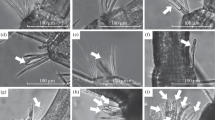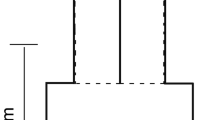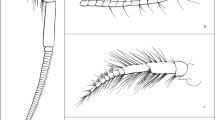Abstract
Aesthetascs are the olfactory receptor organs responsible for mate recognition in many decapod crustacean species. The number of aesthetascs varies greatly among species in different environments, but the functional significance of this variation is poorly understood. This study examined the relationship between social environment and the number of aesthetascs in six species of caridean shrimp in the genus Lysmata. Generally, the number of aesthetascs was greater in group-living species (L. boggessi and L. wurdemanni) than in low-density (L. ankeri and L. pederseni) and pair-living species (L. amboinensis and L. debelius). Aesthetascs are innervated by olfactory receptor neurons (ORNs). The total number of ORNs is related to the sensitivity of olfactory odor detection, and it was higher in group-living species than in pair-living species. Sexual dimorphism in the number of aesthetascs was present in L. boggessi, L. wurdemanni, and L. ankeri but not in L. pederseni and L. amboinensis.



Similar content being viewed by others
Abbreviations
- MP:
-
Male phase
- EP:
-
Euhermaphrodite phase
- ORN:
-
Olfactory receptor neuron
- CL:
-
Carapace length
References
Baeza JA (2009) Protandric simultaneous hermaphroditism is a conserved trait in Lysmata (Caridea: Lysmatidae): implication for the evolution of hermaphroditism in the genus. Smithson Contrib Mar Sci 38:95–110
Baeza JA, Bauer RT (2004) Experimental test of socially mediated sex change in a protandric simultaneous hermaphrodite, the marine shrimp Lysmata wurdemanni (Caridea:Hippolytidae). Behav Ecol Sociobiol 55:544–550
Baeza JA, Schubart CD, Zillner P, Fuentes S, Bauer RT (2009) Molecular phylogeny of shrimps from the genus Lysmata (Caridea: Hippolytidae): the evolutionary origins of protandric simultaneous hermaphroditism and social monogamy. Biol J Linn Soc 96:415–424
Bauer RT (2000) Simultaneous hermaphroditism in caridean shrimps: a unique and puzzling sexual system in the Decapoda. J Crust Biol 20 (Special No. 2):116–128
Bauer RT (2011) Chemical communication in decapod shrimps: the influence of mating and social systems on the relative importance of olfactory and contact pheromones. In: Breithaupt T, Thiel M (eds) Chemical communication in crustaceans. Springer, New York, pp 277–296
Bauer RT, Abdalla JH (2001) Male mating tactics in the shrimp Palaemonetes pugio (Decapoda, Caridea): precopulatory mate guarding vs. pure searching. Ethology 107:185–199
Bauer RT, Caskey JL (2006) Flagellar setae of the second antennae in decapod shrimps: sexual dimorphism and possible role in detection of contact sex pheromones. Invertebr Reprod Dev 49:51–60
Bauer RT, Holt GJ (1998) Simultaneous hermaphroditism in the marine shrimp Lysmata wurdemanni (Caridea: Hippolytidae): an undescribed sexual system in the decapods Crustacea. Mar Biol 132:223–235
Beltz BS, Kordas K, Lee MM, Long JB, Benton JL, Sandeman DC (2003) Ecological, evolutionary, and functional correlates of sensilla number and glomerular density in the olfactory system of decapod crustaceans. J Comp Neurol 455:260–269
Boxhall GA, Yen J, Strickler JR (1997) Functional significance of the sexual dimorphism in the cephalic appendages of Euchaeta rimana Bradford. Bull Mar Sci 61:387–398
Bruce AJ (1983) Lysmata debelius, a new hippolytid shrimp from the Philippines. Rev Fr d’Aquariol Herpetol 4:115–120
Buck LB, Axel R (1991) A novel multigene family may encode odorant receptors: a molecular basis for odor recognition. Cell 65:175–187
Clyne PJ, Warr CG, Freeman MR, Lessing D, Kim J, Carlson JR (1999) A novel family of divergent seven-transmembrane proteins: candidate odorant receptors in Drosophila. Neuron 22:327–338
Daniel PC, Fox M, Mehta S (2008) Identification of chemosensory sensilla mediating antennular flicking behavior in Panulirus argus, the Caribbean spiny lobster. Biol Bull 215:24–33
de Man JG (1888) Bericht über die im indischen Archipel von Dr. J. Brock gesammelten Decapoden und Stomatopoden. Archiv fur Naturgeschichte 53:215–600
Derby CD, Horner AJ, Steullet P, Cate HS (2001) The sensory basis to feeding behavior in the Caribbean spiny lobster Panulirus argus. Mar Freshw Res 52:1339–1350
Fiedler GC (1998) Functional, simultaneous hermaphroditism in female-phase Lysmata amboinensis (Decapoda: Caridea: Hippolytidae). Pac Sci 52:161–169
Ghiradella H, Case J, Cronshaw J (1968a) Structure of aesthetascs in selected marine and terrestrial decapods: chemoreceptor morphology and environment. Am Zool 8:603–621
Ghiradella H, Cronshaw J, Case J (1968b) Fine structure of the aesthetasc hairs of Pagurus hirsutiusculus Dana. Protoplasma 66:1–20
Gibbes LR (1850) On the carcinologial collections of the US, and an enumeration of species contained in them, with notes on the most remarkable, and descriptions of new species. Proc Am Assoc Adv Sci 3:165–201
Gleeson RA (1982) Morphological and behavioral identification of the sensory structures mediating pheromone reception in the blue crab, Callinectes sapidus. Biol Bull 163:162–171
Gleeson RA, McDowell LM, Aldrich HC (1996) Structure of the aesthetasc (olfactory) sensilla of the blue crab, Callinectes sapidus: transformations as a function of salinity. Cell Tissue Res 284:279–288
Gruenert U, Ache BW (1988) Ultrastructure of the aesthetasc (olfactory) sensilla of the spiny lobster, Panulirus argus. Cell Tissue Res 251:95–103
Hallberg E, Johansson KUI, Elofsson R (1992) The aesthetasc concept: structural variations of putative olfactory receptor cell complexes in Crustacea. Microsc Res Tech 22:325–335
Hallberg E, Johansson KUI, Wallen R (1997) Olfactory sensilla in crustaceans: morphology, sexual dimorphism and distribution patterns. Int J Insect Morphol Embryol 26:173–180
Horner AJ, Weissburg MJ, Derby CD (2008) The olfactory pathway mediates sheltering behavior of Caribbean spiny lobsters, Panulirus argus, to conspecific signals. J Comp Physiol A 194:243–253
Johansson KUI, Gefors L, Wallen R, Hallberg E (1996) Structure and distribution patterns of aesthetascs and male-specific sensilla in Lophogaster typicus (Mysidacea). J Crust Biol 16:45–53
Johnson ME, Atema J (2005) The olfactory pathway for individual recognition in the American lobster Homarus americanus. J Exp Biol 208:2865–2872
Jourdan H, Barbier R, Bernard J, Ferran A (1995) Antennal sensilla and sexual dimorphism of the adult ladybird beetle Semiadalia undecimnotata Schn. (Coleoptera: Coccinellidae). Int J Insect Morphol Embryol 24:307–322
Kamiguchi V (1972) On the sexual dimorphism of the antennule of the freshwater prawn Palaemon paucidens. Zool Mag Tokyo Zool Soc 81:223–226
Kamio M, Araki M, Nagayama T, Matsunaga S, Fusetani N (2005) Behavioral and electrophysiological experiments suggest that the antennular outer flagellum is the site of pheromone reception in the male helmet crab Telmessus cheiragonus. Biol Bull 208:12–19
Karavanich C, Atema J (1998) Olfactory recognition of urine signals in dominance fights between male lobsters, Homarus americanus. Behaviour 135:719–730
Koehl MAR (2006) The fluid mechanics of arthropod sniffing in turbulent odor plumes. Chem Senses 31:93–105
Koehl MAR, Koseff JR, Crimaldi JP, McCay MG, Cooper T, Wiley MB, Moore PA (2001) Lobster sniffing: antennule design and hydrodynamic filtering of information in an odor plume. Science 194:1948–1951
Laverack MS, Ardill DJ (1965) The innervations of the aesthetasc hairs of Panulirus argus. Quart J Micr Sci 106(1):45–60
Lin J, Zhang D (2001) Reproduction in a simultaneous hermaphroditic shrimp, Lysmata wurdemanni: any two will do? Mar Biol 139:919–922
Mead KS (2008) Do antennules and aesthetasc structure in the crayfish Orconectes virilis correlate with flow habitat? Integr Comp Biol 48:823–833
Ohtsuka S, Huys R (2001) Sexual dimorphism in calanoid copepods: morphology and function. Hydrobiologia 453(454):441–466
Rani PU, Nakamura K (2001) Morphology of antennal sensilla, distribution and sexual dimorphism in Trogossita japonica (Coleoptera: Trogossitidae). Ann Entomol Soc Am 94:917–927
Rhyne AL, Lin J (2006) A western Atlantic peppermint shrimp complex: redescription of Lysmata wurdemanni, description of four new species, and remarks on Lysmata rathbunae (Crustacea: Decapoda: Hippolytidae). Bull Mar Sci 79:165–204
Shenoy S, Jalihal DR, Sankolli KN (1993) Ecological diversity with reference to aesthetascs in freshwater prawns. Crustaceana 65:300–308
Spencer M, Linberg KA (1986) Ultrastructure of aesthetasc innervations and external morphology of the lateral antennules setae of the spiny lobster Panulirus interruptus (Randall). Cell Tissue Res 245:69–80
Steullet P, Cate HS, Michel WC, Derby CD (2000) Functional units of a compound nose: aesthetasc sensilla house similar populations of olfactory receptor neurons on the crustacean antennule. J Comp Neurol 418:270–280
Steullet P, Dudar O, Flavus T, Zhou M, Derby CD (2001) Selective ablation of antennular sensilla on the Caribbean spiny lobster Panulirus argus suggests that dual antennular chemosensory pathways mediate odorant activation of searching and localization of food. J Exp Biol 204:4259–4269
Vossall LB, Amrein H, Morozov PS, Rzhetsky A, Axil R (1999) A spatial map of olfactory receptor expression in the Drosophila antenna. Cell 96:725–736
Wagele JW (1992) Isopoda. In: Harrison FW, Humes AG (eds) Microscopic anatomy of invertebrates. Wiley-Liss, New York, pp 529–617
Wirtz P (1997) Crustacean symbionts of the sea anemone Telmatactis cricoids at Madeirn and the Cannary Island. J Zool 242:799–811
Wirtz P, de Melo G, de Grave S (2009) Symbioses of decapod crustaceans along the coast of Espírito Santo, Brazil. Mar Biodiv Rec 2:e162. doi:10.1017/S175526720999087X
Zhang D, Lin J (2006) Mate recognition in a simultaneous hermaphroditic shrimp, Lysmata wurdemanni (Caridea: Hippolytidae). Anim Behav 71:1191–1196
Zhang D, Lin J (2007) Effects of density and simulated recruitment and mortality on sex change in a protandric simultaneous hermaphroditic shrimp, Lysmata wurdemanni. Mar Biol 150:639–645
Zhang D, Rhyne AL, Lin J (2007) Density-dependent effect on reproductive behavior of Lysmata amboinensis and L. boggessi (Decapoda: Caridean: Hippolytidae). J Mar Biol Assoc UK 87:517–522
Zhang D, Cai S, Liu H, Lin J (2008) Antennal sensilla in the genus Lysmata (Caridea). J Crust Biol 28:433–438
Zhang D, Lin J, Huang C (2009a) Relationship between olfactory sensor number and mating in a marine shrimp, Lysmata wurdemanni. Mar Freshw Behav Physiol 42:265–273
Zhang D, Lin J, Hardege JD, Rhyne AL (2009b) Reproductive isolation between two sympatric simultaneous hermaphroditic shrimp, Lysmata wurdemanni and L. boggessi. Mar Biol Res 5:470–477
Zhang D, Lin J, Harley M, Hardege JD (2010) Characterization of a sex pheromone in a simultaneous hermaphroditic shrimp, Lysmata wurdemanni. Mar Biol 157:1–6
Ziemba RE, Simpson A, Hopper R, Cooper RL (2003) A comparison of antennules structure in a surface- and a cave-dwelling crayfish, genus Orconectes (Decapoda, Astacidae). Crustaceana 76:859–869
Acknowledgments
We thank Gayle Duncombe of Florida Institute of Technology and Dr. Manfred Schmidt of Georgia State University for assistance in the transmission electron microscopy. We also thank Adeljean Ho and Dr. Mathew Wittenrich of Florida Institute of Technology and Dr. Andy Rhyne of Roger Williams University for shrimp collection. Dr. Judith P. Grassle and three anonymous reviewers provided helpful comments on the manuscript. The study was partially supported by the National Science Foundation of China (project number: 30970445).
Author information
Authors and Affiliations
Corresponding author
Additional information
Communicated by J. P. Grassle.
Rights and permissions
About this article
Cite this article
Zhu, J., Zhang, D., Lin, J. et al. Aesthetascs in Lysmata spp. shrimp: sexual dimorphism and relationship with social environments. Mar Biol 159, 507–517 (2012). https://doi.org/10.1007/s00227-011-1831-3
Received:
Accepted:
Published:
Issue Date:
DOI: https://doi.org/10.1007/s00227-011-1831-3




